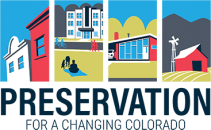Preservation in Placemaking
As Colorado continues to attract new residents and businesses, accommodating growth has put increasing pressure on communities of all types—small to large, rural to urban—to increase in size and density. One of the challenges facing the state in coming decades will be ensuring that growth does not jeopardize or dilute Colorado’s high quality of life.
The sense of place that permeates the state is a leading draw for visitors and residents alike, as are the historic and colorful nature of the built environment. “Placemaking” is a planning strategy that seeks to bolster this sense of place, or to create it from scratch through new developments. In its simplest form, placemaking seeks to create quality places that are pedestrian-oriented, include a mix of housing, commercial, and business uses, are memorable, and exude a sense of unique character.
From small towns to big cities, preserving historic buildings provides a foundation for creating and sustaining memorable places.
“Strategic placemaking” refers to the creation of unique spaces that serve as attractors for talented workers, and has become a vital tool for economic development in recent decades, a virtuous cycle that attracts workers and the corporations that seek them out. “Creative placemaking,” a close cousin, builds on this by seeking to imbue public and private spaces with a sense of place and life, and the process seeks to rejuvenate buildings and streetscapes while improving conditions for businesses.
Placemaking has become an important driver of value in the design of communities. Studies have consistently found increases in property value and multiplier effects in terms of additional private investments throughout communities that have invested in this kind of people-focused placemaking. For example, one study found that properties in walkable urban locations are able to charge rates as high as 74% over peer locations in car-dependent areas. Other studies have found that residents living in walkable communities reap significant personal financial benefits—sometimes referred to as a “green dividend”—of as much as $9,500 annually. In one study, streetscape improvements were even found to increase storefront occupancy rates, encourage private-sector investments, and improve commercial trading by up to 40%. And the benefits of placemaking extend well beyond increases in real-estate value. The benefits of facilitating walkable neighborhoods—much like that seen in Denver’s Union Station District or Golden’s historic core, profiled on these pages—include higher levels of trust and attachment to one’s community than is seen in car-dependent neighborhoods.
Colorado is rich in historic towns and cities that already boast the core elements of effective placemaking. Historic neighborhoods—by necessity designed as walkable, human-scaled places with a mix of residences, businesses, and offices—are well-positioned to capitalize on this trend. Indeed, many new communities designed in the current “placemaking” fashion, like Highland’s Village Garden in Denver, are patterned off older communities. While new communities have a role to play in meeting demand, Colorado’s historic communities are already well positioned to do so. Preserving those characteristics that make them attractive places, and particularly those aspects that no new community can replicate—their historic character and connection to the state’s and community’s history—are now goals championed by many of Colorado’s communities.
The following pages explore the role of preservation in creating meaningful places at a variety of community sizes, starting with rural areas like southeastern Colorado, then in small towns like Cortez and Lamar, and finally in larger urban areas like Golden and Denver.
Placemaking in Rural Communities
While much of the growth in Colorado has been focused around its urban centers, the state’s rural and agricultural communities—and in particular those located in the far eastern and western regions of the state—have generally experienced the opposite trend. While some have benefitted from the state’s growing population, many rural communities continue to struggle with the effects of dwindling populations, shrinking tax bases, and disinvestment in their built environments. Yet, these communities are home to some of the state’s richest cultural and historic assets and are central to understanding the arc of our state’s history, from the homesteading communities of southeast Colorado, to the cultural footprint of generations of Coloradans in the state’s far western reaches, to its many storied main streets.
Placemaking in these rural communities is increasingly understood as a potentially powerful driver of both the economy and of preservation. Recognizing and promoting important historical assets has become a critical component of economic development strategies in recent decades. For example, a recent study from the Colorado Office of Tourism showed that rural counties in the state can reap significant economic benefits from tourism. In Montezuma County, for example, tourism spending in 2015 led to an estimated 1,034 jobs, $20.4 milllion in additional household income, and generated $2.7 million and $2.4 million in state and local taxes, respectively.
Adaptive reuse of historic buildings, such as Cortez’s Montezuma Valley National Bank Building, profiled on this page, have offered opportunities to pair historic preservation with the preservation of regional cultural identity and to greatly bolster the region’s sense of place through a community radio station. Elsewhere, programs like A Home on the Range have restored a sense of place and purpose to regional landscapes that were once woefully undervalued and neglected, while Main Street programs such as Lamar’s are helping communities to breathe fresh life into their present, while tipping their hats to the history of their communities.
Just as Colorado’s fast-growing communities are learning how to effectively partner growth and preservation, smaller communities throughout the state are also learning to harness preservation and placemaking for their own sustainability.

